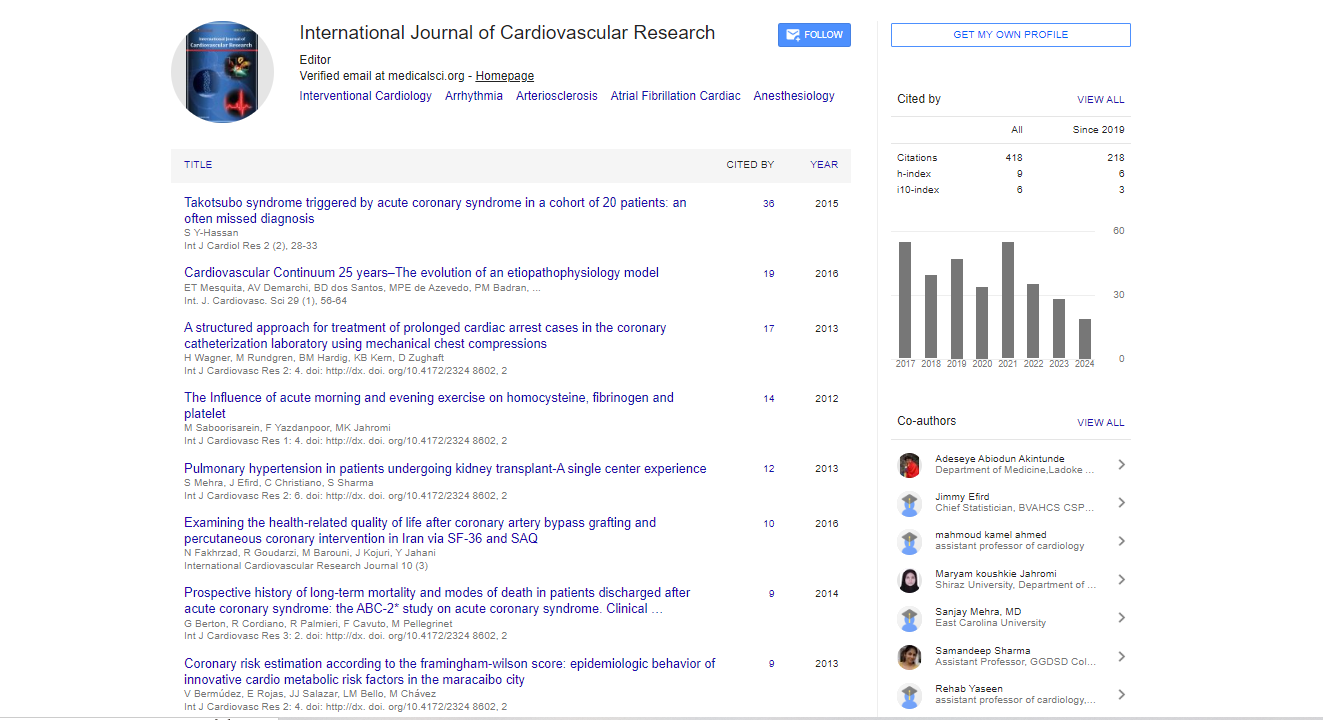Research Article, Int J Cardiovasc Res Vol: 4 Issue: 4
Revascularization of TASC C/D Iliac Occlusion Extended to Common/Superficial Femoral Artery using a Mixed Endoluminal and Subintimal Technique through the RadioBrachial Access
| Gianluca Rigatelli1*, Dobrin Vassiliev2, Fabio dell’Avvocata1, Alberto Rigatelli1, Massimo Giordan1 and Paolo Cardaioli1 | |
| 1Department of Cardiovascular Diagnosis and Endoluminal Interventions Unit, Rovigo general Hospital , Rovigo, Italy | |
| 2Department of Interventional Cardiology, Alexandrovska Hospital, Sofia University Medical School, Sofia, Bulgaria | |
| Corresponding author :Gianluca Rigatelli, MD Department of Cardiovascular Diagnosis and Endoluminal Interventions Unit, Rovigo General Hospital , Rovigo, Italy Fax: +3904254513 E-mail: jackyheart71@yahoo.it |
|
| Received: February 14, 2015 Accepted: April 20, 2015 Published: April 22, 2015 | |
| Citation: Rigatelli G, Vassiliev D, dell’Avvocata F, Rigatelli A, Giordan M, et al. (2015) Revascularization of TASC C/D Iliac Occlusion Extended to Common/ Superficial Femoral Artery using a Mixed Endoluminal and Subintimal Technique through the Radio-Brachial Access J Cardiovasc Res 4:4. doi:10.4172/2324-8602.1000217 |
Abstract
Revascularization of TASC C/D Iliac Occlusion Extended to Common/Superficial Femoral Artery using a Mixed Endoluminal and Subintimal Technique through the RadioBrachial Access
Background: Patients with Trans-Atlantic Inter Society Consensus (TASC) C and D iliac lesions extended to common and/or superficial femoral artery are a very challenging subset of patients. Objective: The aim of this study is to discuss the technical implication and short-term outcome of endovascular revascularization through the radio-brachial access using a mixed endoluminal and subintimal recanalization using a Mmxed endoluminal and subintimal technique. Methods: From January 2010 to Jannuary 2015 We prospectively enrolled 33 consecutive patients (mean age 79 ± 12.5 years) , with long (>80 mm) TASC C and TASC D symptomatic chronic iliac arteries occlusion extended to the common/superficial femoral artery, judged not candidates for surgery. Procedure was attempted through the left radial or brachial artery by means of a mixed endoluminal and subintimal recanalization technique using coronary and peripheral dedicated guidewires. Results: The procedure was successful in all but one case (96.9%), mean length and diameter of implanted stents were 160.4 ± 30.2 mm and 8.6 ± 1.4 mm (Everflex EV3 in 20 patients, Pulsar in 3 patients, Smart Flex in 10 patients) , respectively. The procedure was successful in 32/33 patients (96.9%): mean length and diameter of implanted stents were 160.4 ± 30.2 mm and 8.6 ± 1.4 mm (Everflex EV3 in 20 patients, Pulsar in 2 patients, Smart Flex in 10 patients) , respectively. Complications rate was 9.1% including two vessel ruptures and one distal embolization. Death rate was 3%. At a mean follow up of 18.1 ± 11.2 montshs, the primary and secondary patency rates were 90.1 and 96.9%, respectively with a significant improvement of ABI (0.29 ± 0.6 versus 0.88 ± 0.3, p<00.1) and Rutherford class (5.3 ± 0.8 versus 0.7 ± 1.9, P <0.01) compared to baseline. Conclusion: The described technique appeared to be effective and safe allowing for recanalization of long iliac occlusion extended to common/superficial femoral artery.
 Spanish
Spanish  Chinese
Chinese  Russian
Russian  German
German  French
French  Japanese
Japanese  Portuguese
Portuguese  Hindi
Hindi 



